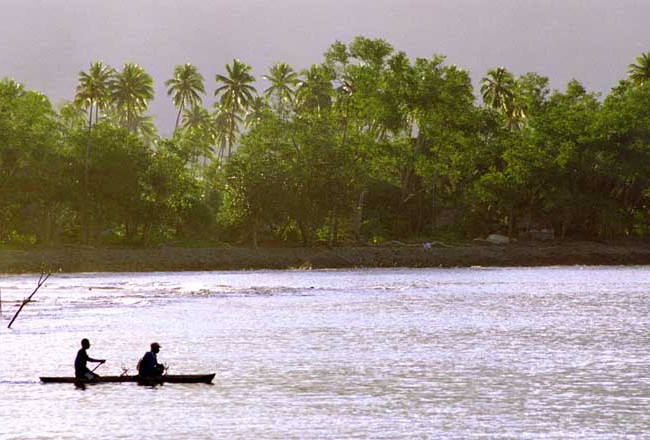
Plenty of talk about ‘resilience’
The term ‘resilience’ is much in vogue in the world of disaster preparedness and climate action. Donor countries and agencies are today heavily focused on ‘building resilience’ of small island countries. A multitude of in-country workshops and training programs, and multi-nation collaborative projects are being funded to help islands improve their capacity to respond to natural disasters and the existential threat from our changing climate and rising ocean levels.
A key challenge for many islands is that most aid projects are initiated by donors and urban center-based government officials with little participation from outer islanders and local community leaders in addressing sustainability needs of the country. An important question to ask: Who is ‘resilient’ in the Pacific? Certainly not people in the urban centers, which would collapse if container ships stopped arriving in ports to disgorge their cans of corned beef, bags of rice, and cases of cola. People living in villages outside urban centers or on remote islands depend to a greater degree today on imported goods than in years past. But if the ships stopped coming, outer islanders would survive while their urban cousins wouldn’t.
An even more significant effect on development planning is that within the past 30 years, there has been heavy migration into Pacific island cities, with demographics changing in many islands from majority of people in remote areas to increasing numbers in the centers. The Marshall Islands is a prime example: In the 1960s, 75 percent of the population lived outside of Majuro and Ebeye, the two urban areas. Today, it’s exactly the opposite. In contrast to earlier generations of leaders and government officials who led the islands from the 1960s to the 1990s, today in many islands a majority of people are born and raised in the centers totally disconnected from their outer island roots. What this means is the younger generation of government staff managing development projects don’t have a connection to the rural areas and this is reflected in urban-centered development planning.
An Asian Development Bank report issued in 1997, ‘Supporting and Sustaining Fisheries in the Marshall Islands: A Sociological Report’, made the observation: ‘Some government officials are out of touch with community realities, shielded by their high salaries and lives in urban centers, their frequent trips overseas.’ Written 17 years ago, but it is certainly descriptive of the state of affairs in many governments today.
In a report I wrote for the Japan International Cooperation Agency (JICA) in 1998, on decentralized and participatory development, I observed: ‘The vast majority of goals, objectives and action plans for everything from fisheries to family planning are written by outside consultants.’ This situation is even more pervasive today. And if one thing is true, 99 percent of outside consultants know even less about outer island needs and challenges than the urban islander.
We talk about ‘resilience’ all the time in workshops and funding proposals, but we generally ignore the population that is most resilient: outer islanders and rural villagers. One hundred years ago, when a cyclone swept through, there was no International Red Cross or U.S. Agency for International Development to swoop in with food, water and other aid. Life was harder, but traditional systems were honed over centuries so that islanders could live on the most remote, resource-poor atoll. These traditional systems, many of which are still in practice in rural areas, conserve coastal fisheries, manage agriculture crops, and govern teaching of navigation, canoe building and local medicine. It seems to me, we have a lot to learn about resilience from outer islanders, and should be incorporating traditional systems into resource management because they have worked for centuries. Yet most aid projects deliver things — solar lights, water catchment tanks, small fishing boats — to outer islanders instead of involving them in the development ‘conversation.’
The University of the South Pacific operates a Pacific Centre for Environment and Sustainable Development but sustainable development centers seem to be few and far between in the island region. Institutionalizing community participation in development requires ongoing educational programs about sustainable development and access to information about resources available for community development. Most islands have no center for community-based development activities that could act as a catalyst and entry point for engagement with the wider community. A reoccurring complaint of community representatives, particularly in the outer islands, is that not only don’t they have easy access to resources, they don’t even know who to ask or where to look for opportunities, skills training, and technical assistance. And it’s obvious why: those are concentrated in urban centers by urban-centered government officials.
It would make a lot of sense for universities and community colleges in each island to offer sustainable development courses for students and to take the further step to establish centers for sustainable community-based development, which could be integrated with ongoing research and educational programs of these colleges. We need to get out of our urban thinking box, engage rural communities, and talk to the people who are the most resilient in our islands about building resilience elsewhere.

